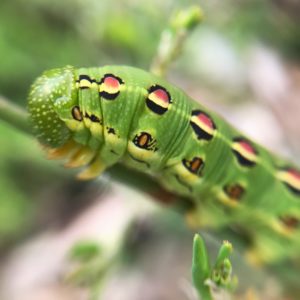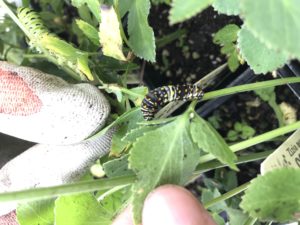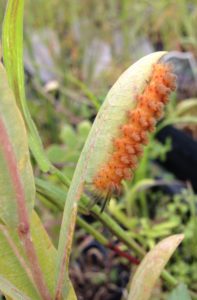This time of year is great for caterpillar hunting. I have been finding lots of amazing, colorful critters munching away on the foliage here at Dyck Arboretum. I am always eager to get a picture of them, if I can, so that I can properly identify them later using guides and help from the internet. In doing so, I become engrossed in their beautiful and strange anatomies – spots, stripes, horns, hairs and amazingly grippy legs. There is much to know and discover!

I get close up photos of insects on my phone using a clip on macro lens. By doing so I can see the tiny details on this white-lined sphinx moth caterpillar (Hyles lineata), like the yellow tips on his legs and the white spots on his head.
Caterpillars vs Worms
When a child sees a caterpillar, they might be tempted to point and say “Oooh, worm!”. But we must remember that caterpillars are not worms, they are larvae. Larvae is the immature form of an insect. A true worm, such as an earthworm, isn’t an immature form of anything. There are several other easy to notice differences:
- Worms do not move on legs – Caterpillars do
- Worms are not insects, and do not metamorphose into insects – Caterpillars change into an adult butterfly or moth
- Worms can be microscopic or gigantic, up to 180 ft long! – Caterpillars are visible, but not larger than 12cm
Also, caterpillars often sport wacky colors and patterns while most of the world’s worms are much more inconspicuous. Earthworms and some marine worms, roundworms, and tapeworms are usually sporting brown or tan skin. However, many types of ocean dwelling flatworms are incredibly colorful, though you won’t likely confuse these guys for caterpillars.

An adult black swallowtail caterpillar feeding on Zizia in our greenhouse. These swallowtails can only feed on plants in the Parsley/Carrot family.

This black swallowtail caterpillar is in one of its early ‘instars’ or phases of development. It will shed its skin as it gets bigger, and coloration changes during this process as well. In the top left, you can see a black swallowtail caterpillar farther along in its development.
Hairy and Scary
Caterpillars are genius defense players. They are so packed full of protein and delicious to predators, they have had to evolve many ways to protect themselves. Some caterpillars, like the monarch butterfly, make themselves taste bad by eating milkweed leaves with toxins in them. Others try to look intimidating with aposematic coloration – body patterns and colors that warn predators to stay back! And some, like the spicebush swallowtail, even grow fake eye spots on their bodies to fool their hunters into thinking they are snakes. My personal favorites are the hairy ones. Caterpillars will sometimes grow hairs to make them hard or unpleasant to swallow. What bird wants a mouth full of hair anyways? Sometimes these hairs are designed to fall off and lodge in the skin/mucus membrane of whatever is disturbing it, causing an itchy rash in some people.

This is a cycnia moth caterpillar feeding on Asclepias sullivantii in our plant nursery. This little guy needs milkweed just as much as the monarchs, but doesn’t get the same press for some reason. I made sure not to touch him because of all those potentially itch-inducing hairs!
In part II of this topic, I will talk a little bit about the specific parts of their body, special caterpillar diets, silk making abilities, and how you can design your very own caterpillar-attracting butterfly garden. Until then, keep a lookout for these special critters and do a little discovering of your own!
